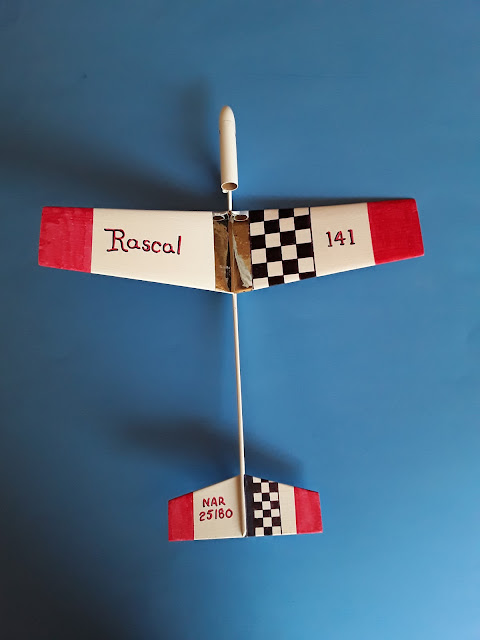Designed by Paul Conner II
Scratch-built from published plans: Model Rocketeer Magazine, October, 1973.
Completion Date: August 31st, 2022
Class 1/2A Competition rocket/glider
Motor type: 13mm
Length: 35.1cm (13.82 in.)
Wingspan: 30.5 cm (12.0 in.)
Weight Empty: 13 g. (.46 oz.)
Color Scheme: White, Red, Black, Silver
An Old Fleet Glider Favorite
Back in the early 70s, the NAR introduced a new competition event called Rocket/Glider Duration, in which the model could not seperate into more than one unattached piece. Everything that went up...came down together, including the motor casing.
Competition rocketeers of the day scrambled to come up with ways to accomplish this. Many of the designs incorporated ejection charge activated moving parts to change CG or CP locations to allow the models to transition from boost to glide phases without jettisoning any parts. These 'variable geometry' designs used such things as sliding wings, flop-wings, folding wings, sliding pods, ejectable flexwings - you name it.
Paul Conner's Rascal did not use any of these. Instead, it is a fixed engine design, relying on the weight of the engine propellant to provide boost stability and the expended casing weight to balance the model for gliding flight. This means that there is a very tight window of frontal weight difference to trim the model for both phases of flight. Not an easy feat.
The Rascal was designed for 1/2A motor duration events - 'Hornet' class in the NAR nomenclature of the day. Paul's model was one of the earliest published plans for the event.
I built a Rascal back in my early days of involvement in model rocketry, probably for a rocket/glider event at a contest meet held by the Skywatchers/ROMAR club in Colorado Springs. I'll search my Old Fleet archives for whatever info I can find on that glider model for a future post here on the blog.
The Rascal is a standard configuration glider utilizing a fixed pod glued to the front pylon. Holes punched at the fore end of the motor tube vent the ejection gasses.
This 2022 version of the Rascal is built exactly to the plans except for the nose cone. The original called for a hollowed out BNC-5V balsa cone. The similar sized current Estes plastic cone is substituted here. Weight difference should be negligible.
The only other deviation from the plans was the addition of a slight amount of negative incidence to the horizontal stab.
I finished the Rascal using my tried and true method - spraying on a coat of white sandable primer and sanding the entire model to provide a great surface for coloring with permanent markers.
 |
| The bottom side of the wings are colored black for higher visibility. |
 |
| The Rascal in primer prior to coloring with permanent markers. |
On a whim, I decorated one wing and a section of the horizontal stab with a checkerboard pattern, reminiscent of photos of European glider models I've seen in old Model Rocketry Magazine issues.
I highly anticipate getting this first completed model of the 2022 Binge Build out for glide trimming and powered flight! I'll be sure to let you know how it goes....

